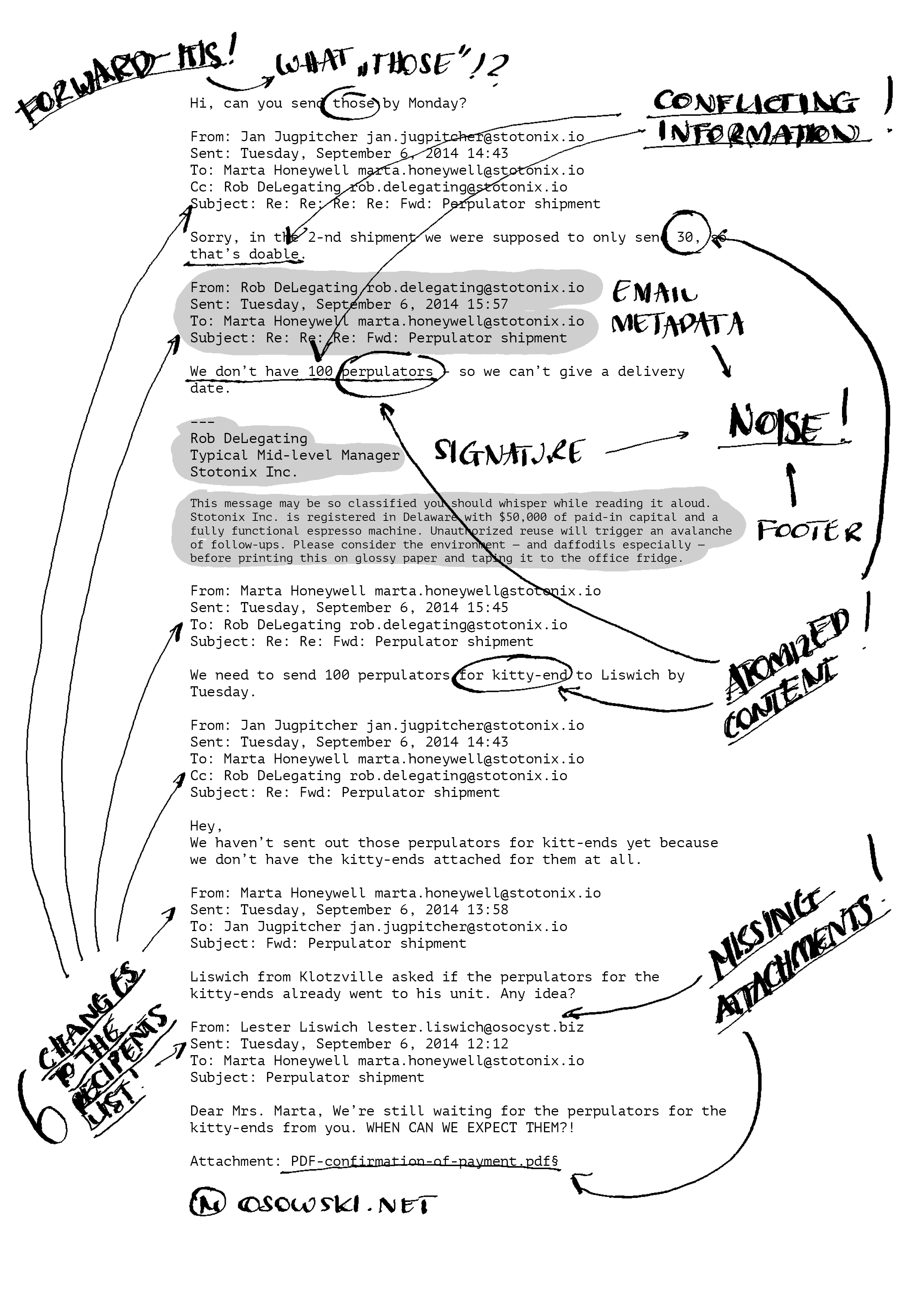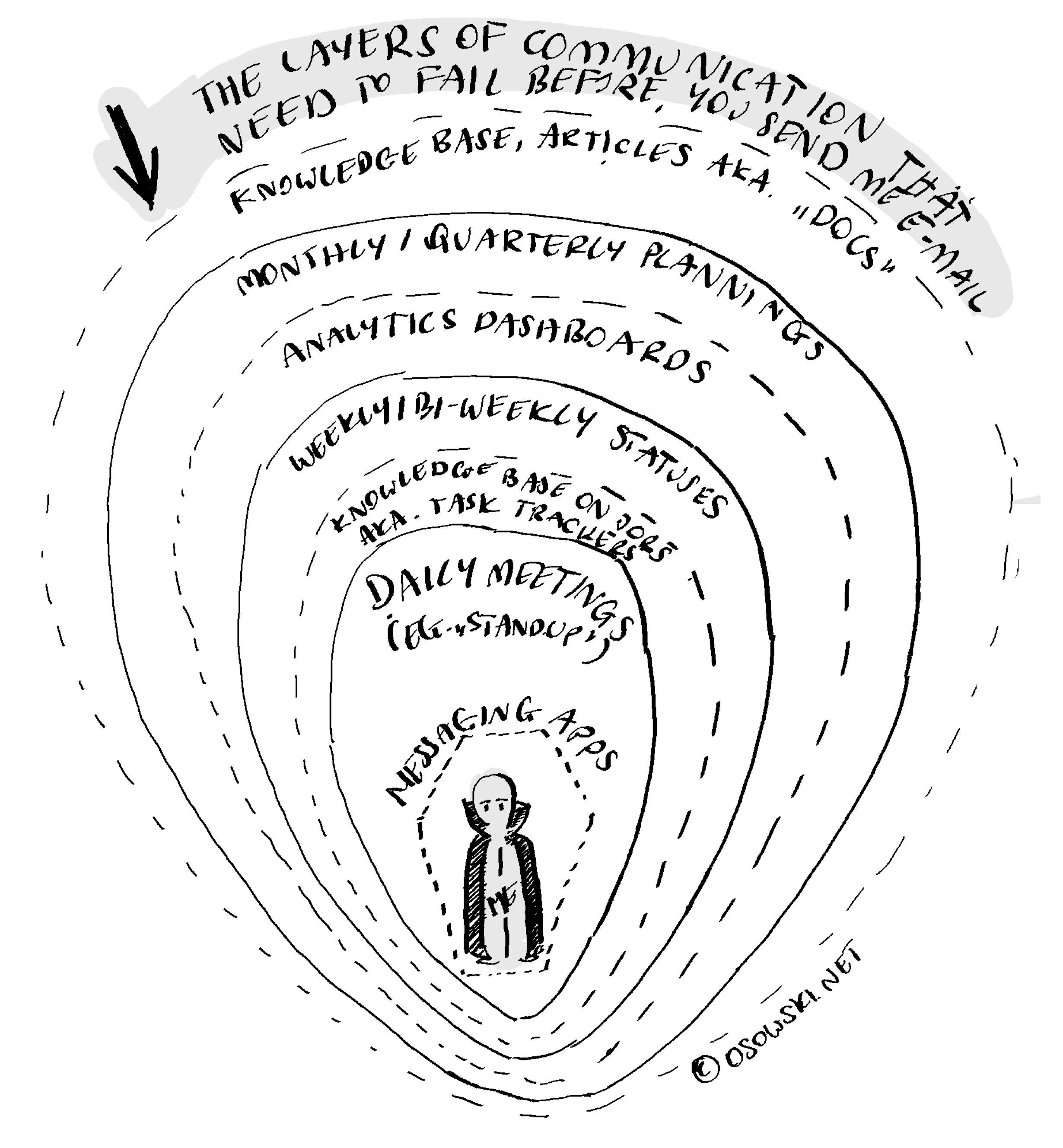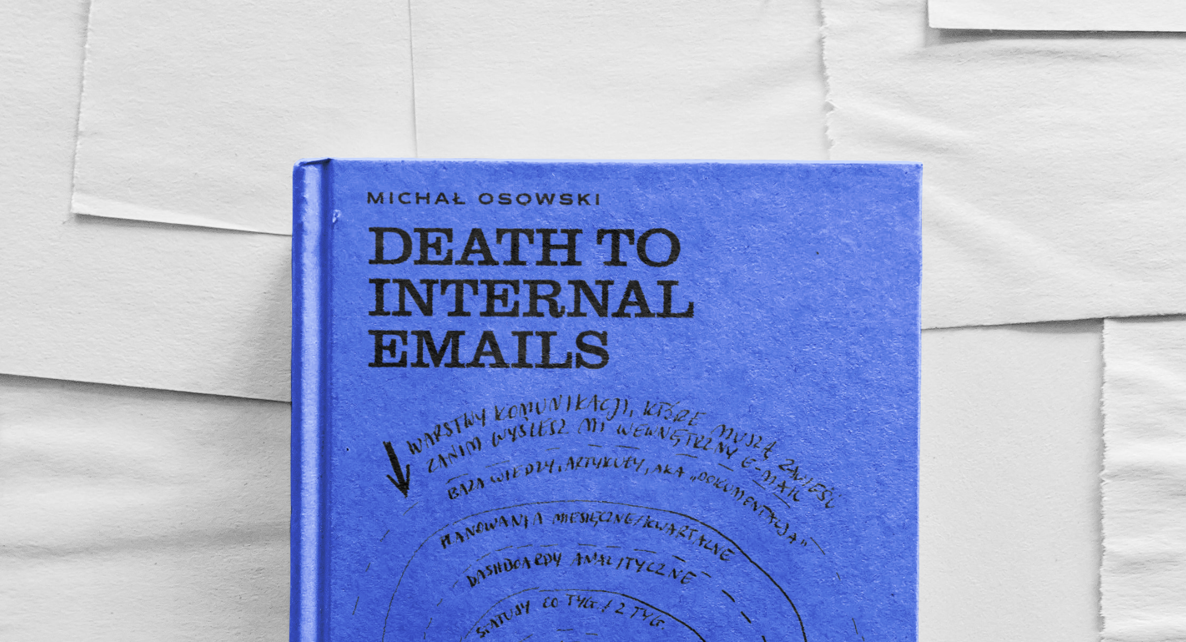If we work at the same company and you need to send me an email – something has gone seriously wrong. Here’s why I think it’s time to ditch internal epistolography altogether.
I stopped reading internal email in 2017 – 1 pandemic and ~3 employers ago. Almost. It's not that my inbox is lonely. I’m a Product Director – 100+ messages crash-land there every 24 hours, Valentine’s Day or not. I'm sure the same thing happens in yours. ❶ And, same as for you, most of them add zero value – for me, my team, or our product. ❷
So why do we still cling to a tool that’s about as efficient as state socialism? Especially when we replaced it ages ago? And how can you (at least partly) break out of this vicious circle?
The 7 Deadly Sins of Internal Email
Sending an email outside the company can feel stressful; shooting one to even a huge list of coworkers is as easy as peeling a banana. That very human impulse – plus a few purely technical quirks – gives us seven deadly sins of internal email:
- Static content – Once an email (or its attachment) is sent, you can’t update it, which leads straight to…
- Message atomisation – Like a furious ping-pong rally, even the rare “constructive” threads splatter fragments of information across dozens of replies. New messages often invalidate the old ones, creating contradictions.
- Low bar for senders and recipients – Anyone in the company can email you. No expertise, no permissions needed – just an address book access and a heart full of malice. There’s also no access control for e-mails: you can’t link to an email, and sharing the information means forwarding it again, which triggers…
- Forward-itis – The modern plague of “you forgot to add John”, “sorry, this wasn’t meant for everyone”, “CC-ing you just FYI”, or “all the context is in this [two-year] thread”. The trick here is shifting the work of crafting a clear message from the sender to the unlucky reader.
- Format mismatch – Email is for messaging, not knowledge storage. With zero internal structure, every author invents a new layout. Noise piles up – greetings, sign-offs, mile-long GDPR footers – while purpose-built collaboration features (rich formatting, macros, live updates, visualisations, summaries) simply don’t exist.
- No context – Even if an email is (a) threaded, (b) filtered into folders, and (c) sent through mailing lists, the inbox stays fundamentally flat. Each new thread lands on the same endless pile; nothing is anchored to a project, task, or team
- Communication drag – Thanks to all of the above, we write and read emails more slowly, need more words to get things done, and achieve weaker results. Quality can sink without limit – an opportunity our colleagues seem to grab faster than free company fruit on Tuesdays.

The list above is still open – I’d love even more creative slams on internal email in the comments. But how do you escape the evil? How do I manage to check email only once a week and still be considered tolerable by the team? The answer is simple.
How to bury internal emails?
Sometimes our lives go through long-term changes that demand self-awareness, commitment, and discipline. Ditching internal emails is not one of them. In my case, it happened spontaneously and almost by itself, and the last nail in the coffin was adding a knowledge base (Confluence) to our company toolset. For the DIY enthusiasts – the whole coffin looks roughly like this:

Using the right mix of tools and meetings turns internal email from the default into a faux pas. It lets internal email take its rightful place in hell – right next to leaving someone a voicemail, planning projects in PowerPoint, and Judas. The system basically runs itself. Some folks dress it up on their résumé as “a proactive approach to communication,” but to me it’s just "common sense":
- meetings – default length is 30 minutes; the need to communicate emerges over time; I sync with my team every day; with the people who’ll get fired if I miss the deadline – every two weeks; with the people who will be firing them – once a quarter,
- chat – if your need to talk is urgent and rare, ping me in chat: less noise, faster turnaround, and we can pull more people in if needed,
- knowledge base for tasks ("task tracker”) – e.g. Jira, Trello – enter the task details once and the system notifies the requester, the assignee, and everyone in between – all at once,
- analytics dashboard – if your communication need is cyclical and passive, and about results rather than the work itself, I can probably serve the data to you passively and automatically,
- knowledge base for facts (“documentation”) – e.g. Notion, Confluence – if your question isn’t about the work or its outcomes but is still legit, odds are you’re not the only one who needs the answer: instructions, troubleshooting guides, and reference material land in the docs ahead of time.
Looking at the above, if we work at the same company and you still have to email me, something has gone seriously wrong. I either failed to share some fact or task detail up front, or maybe you only think you need/deserve to know something. Either way, we can usually clear it up faster than a TikTok trend. We toss in a status update/chat/task/dashboard/document and move on. It's clean and efficient. It’s Friday, 5:01 p.m. We’re all “one step ahead of the competition,” and “the money practically prints itself.” So, are internal emails totally dead? Not quite.
Internal Emails Strike Back
While statistically 70% of internal emails ❸ are pure spam, the rest are absolutely essential and deserve pride of place in our inboxes and hearts. The list is open, but I’d single out:
- legal notices (e.g., HR updates, offers) – the plain, transactional nature of an email promotes accountability, and courts around the globe already treat it as standard evidence ❹❺;
- escalations and CYA (“cover-your-ass”) emails – culturally, and probably for the same legal reason, email is often “the last resort” and “for real”; we use it to confirm what was decided in a meeting or chat; as long as it’s summarising, not substituting project docs, it’ll do;
- technical notices sent to service customers – no matter how "state-of-the-art" your service mesh is, the only thing I trust is a hard-wired rule: subscribe the client-team alias to the service-owner’s mailing list and fire off a good old email notice every time we plan a change (or an apology if we’ve already deployed it); everything else fails.
Ultimately, it all boils down to work culture. I’m no saint, but still – given that it’s 2025 – forwarding an email thread without a summary, or blasting a year-long project plan to 30 people in a static Excel file, feels… downright gross.
If you feel the same, forward this piece to the desk-mate who’s raging at company spam with you, or use it as a veiled hint for the nearest “Reply-all” fan.
Cutting yourself off from corporate spam is a gamble you take at your own risk, but trust me – it doesn’t have to hurt. Let me know how your email-taming quest is going; we all face this problem, and I’d love to hear your take in the comments.
Sources
① Average employee receives approximately 121 emails per day. Venngage. (2023). 25 Key Email Statistics Defining the Modern Email Landscape. Venngage. Consensus
② 43% of employees feel that internal communications are ineffective, leading to misunderstandings. ProofHub. (2024). What is Internal Communication? A Guide for Organizations.
③ Only 30% of emails received are important or require immediate action. Global News. (2017). This is how much time you spend on work emails every day, according to a Canadian survey.
④ 85% of U.S. corporations were involved in litigation where emails served as key evidence in 2019. Symantec. (2019). Internet Security Threat Report, Volume 24.
⑤ 70% of civil cases involving businesses dealt with email communication in 2019. NinjaOne. (2019). Small Business Cyber Security Statistics.

